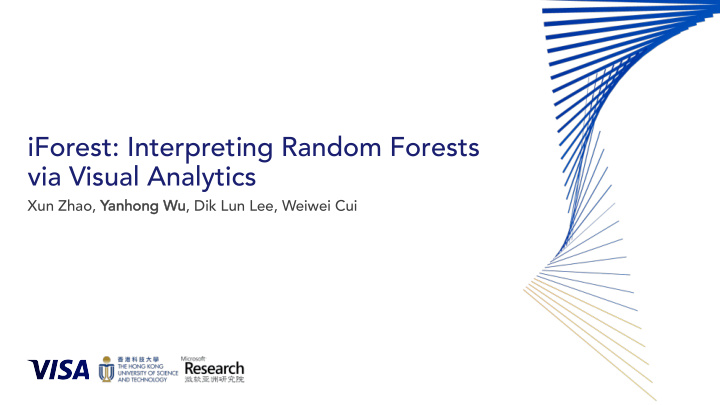



iForest: Interpreting Random Forests via Visual Analytics Xun Zhao, Ya Yanhong Wu , Dik Lun Lee, Weiwei Cui
Background • Random Forest Fraud Detection Medical Diagnosis Churn Prediction 1 Icons created by Anatolii Babii, Atif Arshad, and Dinosoft Labs from the Noun Project.
Background – Decision Tree 2
Background – Decision Tree 3
Background – Random Forest 4
Background – Random Forest 5
Background – Random Forest 6
Motivation – Random Forest 7
Random Forests are A+ predictors on performance but rate an F on interpretability L. Breiman “Statistical modeling: The two cultures.” 8
Interpretability 9 Source: https://xkcd.com/1838/
Interpretability Reveal the relationships between features and predictions Uncover the underlying working mechanisms Provide case-based reasoning 10 Icons created by Melvin, alrigel, and Dinosoft Labs from the Noun Project.
iForest: Interpreting Random Forests via Visual Analytics 11
iForest - Visual Components Data Overview Feature View Decision Path View 12
Demo
iForest – Data Overview Data Overview Feature View Decision Path View Provide case-based reasoning 14
iForest – Data Overview • Methods: confusion matrix and t-sne projection Predicted Values True False True False True Actual Values Positive Negative False True False Positive Negative 15
iForest – Data Overview • Methods: confusion matrix and t-sne projection Negative Positive each circle represents a data item Default View Panning & Zooming 16
iForest – Feature View Data Overview Feature View Decision Path View Reveal the relationships between features and predictions 17
iForest – Feature View • Methods: data distribution and partial dependence plot each cell illustrates the statistics and importance of a feature 18
iForest – Feature View • Methods: data distribution and partial dependence plot high Feature A (numerical) 19
iForest – Feature View • Methods: data distribution and partial dependence plot high x = 60 Feature A (numerical) 20
iForest – Feature View • Methods: data distribution and partial dependence plot Split point distribution Feature A (numerical) 21
iForest – Feature View • Methods: data distribution and partial dependence plot high Feature B (ordinal) high 22
iForest – Feature View Data Overview Feature View Decision Path View Uncover the underlying working mechanisms 23
iForest – Decision Path View • Goal: audit the decision process of a particular data item 24
iForest – Decision Path View • Decision Path Projection ration between positive and negative decision paths each circle represents a decision path lasso to select a specific set of paths for exploration Negative Positive 25
iForest – Decision Path View • Feature Summary Feature Cell: Summarize the feature ranges of the selected paths pixel-based bar chart: feature range summary vertical bar: feature value of the current data item 26
iForest – Decision Path View • Feature Summary Layer 1 (root) Layer 2 Layer 3 Decision Path I: A < 0.5 C < 3.5 C > 1.5 C > 2.5 A < 0.5 Decision Path II: 27
iForest – Decision Path View • Feature Summary Layer 1 (root) Layer 2 Layer 3 Decision Path I: A < 0.5 C < 3.5 C > 1.5 C > 2.5 A < 0.5 Decision Path II: 28
iForest – Decision Path View • Feature Summary Layer 1 (root) Layer 2 Layer 3 Decision Path I: A < 0.5 C < 3.5 C > 1.5 C > 2.5 A < 0.5 Decision Path II: 29
iForest – Decision Path View • Feature Summary Layer 1 (root) Layer 2 Layer 3 Decision Path I: A < 0.5 C < 3.5 C > 1.5 C > 2.5 A < 0.5 Decision Path II: 30
iForest – Decision Path View • Decision Path Flow: layer-level feature ranges Leaf Node Leaf Node 31
Evaluation – Usage Scenario • Two usage scenarios using the Titanic shipwreck and German Credit data • Titanic shipwreck statistics: • 891 passengers and 6 features after pre-processing • German Credit statistics: • 1,000 bank accounts and 9 features 32
Usage Scenario – Titanic
Evaluation – User Study • Qualitative user study • 10 participants recruited from local university and an industry research lab • 10 tasks covering all important aspects in random forest interpretation • 12 questions related with iForest usage in a post-session interview Task Completion Time (seconds) 30 25 20 15 10 5 0 Task 1 Task 2 Task 3 Task 4 Task 5 Task 6 Task 7 Task 8 Task 9 Task 10 34
Future Work • Support other tree-based model such as boosting trees • Support multi-class classification or regression • Support random forest diagnosis and debug 35
Q&A iForest: Interpreting Random Forests via Visual Analytics Yanhong Wu Email: yanwu@visa.com URL: http://yhwu.me
Recommend
More recommend